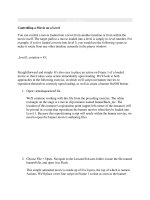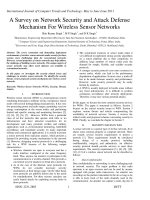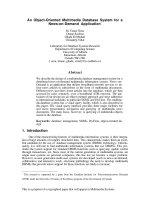A Dialogue on Memory Virtualization
Bạn đang xem bản rút gọn của tài liệu. Xem và tải ngay bản đầy đủ của tài liệu tại đây (31.09 KB, 2 trang )
12
A Dialogue on Memory Virtualization
Student: So, are we done with virtualization?
Professor: No!
Student: Hey, no reason to get so excited; I was just asking a question. Students
are supposed to do that, right?
Professor: Well, professors do always say that, but really they mean this: ask
questions, if they are good questions, and you have actually put a little thought
into them.
Student: Well, that sure takes the wind out of my sails.
Professor: Mission accomplished. In any case, we are not nearly done with
virtualization! Rather, you have just seen how to virtualize the CPU, but really
there is a big monster waiting in the closet: memory. Virtualizing memory is
complicated and requires us to understand many more intricate details about
how the hardware and OS interact.
Student: That sounds cool. Why is it so hard?
Professor: Well, there are a lot of details, and you have to keep them straight
in your head to really develop a mental model of what is going on. We’ll start
simple, with very basic techniques like base/bounds, and slowly add complexity
to tackle new challenges, including fun topics like TLBs and multi-level page
tables. Eventually, we’ll be able to describe the workings of a fully-functional
modern virtual memory manager.
Student: Neat! Any tips for the poor student, inundated with all of this information and generally sleep-deprived?
Professor: For the sleep deprivation, that’s easy: sleep more (and party less).
For understanding virtual memory, start with this: every address generated
by a user program is a virtual address. The OS is just providing an illusion
to each process, specifically that it has its own large and private memory; with
some hardware help, the OS will turn these pretend virtual addresses into real
physical addresses, and thus be able to locate the desired information.
1
2
A D IALOGUE ON M EMORY V IRTUALIZATION
Student: OK, I think I can remember that... (to self) every address from a user
program is virtual, every address from a user program is virtual, every ...
Professor: What are you mumbling about?
Student: Oh nothing.... (awkward pause) ... Anyway, why does the OS want
to provide this illusion again?
Professor: Mostly ease of use: the OS will give each program the view that it
has a large contiguous address space to put its code and data into; thus, as a
programmer, you never have to worry about things like “where should I store this
variable?” because the virtual address space of the program is large and has lots
of room for that sort of thing. Life, for a programmer, becomes much more tricky
if you have to worry about fitting all of your code data into a small, crowded
memory.
Student: Why else?
Professor: Well, isolation and protection are big deals, too. We don’t want
one errant program to be able to read, or worse, overwrite, some other program’s
memory, do we?
Student: Probably not. Unless it’s a program written by someone you don’t
like.
Professor: Hmmm.... I think we might need to add a class on morals and ethics
to your schedule for next semester. Perhaps OS class isn’t getting the right message across.
Student: Maybe we should. But remember, it’s not me who taught us that the
proper OS response to errant process behavior is to kill the offending process!
O PERATING
S YSTEMS
[V ERSION 0.90]
WWW. OSTEP. ORG









